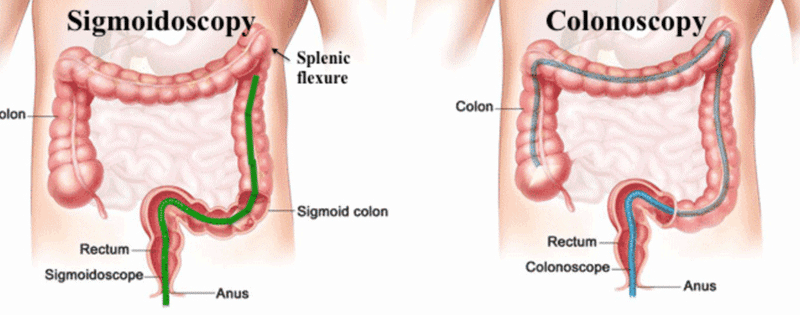Colonoscopy vs. Sigmoidoscopy

Colon cancer is one of the most common cancers in the United States, and getting screened beginning at a certain age is of utmost importance. Most doctors agree that people should have their first colonoscopy at the age of 50. If you have a first-degree relative with colorectal cancer, your screening should begin at the age of 40, or 10 years younger than the relative was when originally diagnosed.
Colon – Problems and Treatments →
There’s no question that a screening can save your life. However, some wonder whether a colonoscopy procedure is the best. As the most widely used colon cancer screening, a colonoscopy examination of the large intestine allows for an entire view of the colon and rectum. A standard procedure takes approximately 30 minutes and the patient is given medication to sleep while the colonoscope is used to view the intestinal tract.
What is colonoscopy
A colonoscopy is a medical procedure that allows a doctor to examine the inside of the colon (large intestine) using a long, flexible tube called a colonoscope. The colonoscope has a light and a small camera on the end, which allows the doctor to see the inside of the colon and identify any abnormal growths, such as polyps or cancer.
Colonoscopy is used as a screening test for colon cancer, as well as to diagnose and treat other conditions of the colon, such as ulcerative colitis, diverticulitis, and bleeding. It is recommended that people over the age of 50 get a colonoscopy every 10 years as a screening test for colon cancer or earlier if there is a family history or other risk factors.
What is a sigmoidoscopy
A sigmoidoscopy is a medical procedure that allows a doctor to examine the inside of the sigmoid colon and rectum using a short, flexible tube called a sigmoidoscope. The sigmoidoscope has a light and a small camera on the end, which allows the doctor to see the inside of the lower portion of the colon and identify any abnormal growths, such as polyps or cancer.
Sigmoidoscopy is used as a screening test for colon cancer, as well as to diagnose and treat other conditions of the colon, such as ulcerative colitis, diverticulitis, and bleeding. It is considered less invasive than colonoscopy, but it only allows visualization of the lower portion of the colon, the sigmoid colon, and rectum. A colonoscopy is needed to examine the entire colon.
Comparison colonoscopy vs. sigmoidoscopy
Both the colonoscopy and sigmoidoscopy are used to as a test to detect colon polyps or colon cancer. In comparison, though, the sigmoidoscopy method surveys only the lower part of the colon and the rectum. At 2′ long, a sigmoidoscope is able to see less than half (the lower 1/3rd) of the colon. Although the sigmoidoscopy does require less prep on the part of the patient, less sedation, and takes an average time of 15-20 minutes. The major disadvantage of a sigmoidoscopy is that it only allows viewing and removal of precancerous colon polyps from the left side of the colon, where two out of three colon cancers develop.
If caught early, removing colorectal polyps/cancer can save your life, so undergoing one of these procedures can be of utmost importance. Discussing options with your doctor is key in selecting the right procedure for you. When performed by a licensed and trained professional, both procedures are a safe way to protect your health.












